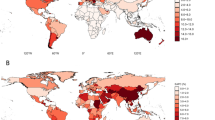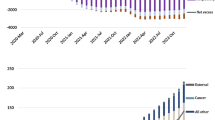Abstract
After the fall of the Berlin Wall in 1989 the former communist countries of central and eastern Europe underwent substantial social and economic changes that had a major impact on health. The situation of the former German Democratic Republic was unique in that its existing institutions were replaced rapidly and it was quickly integrated economically with the West. This study describes recent trends in morbidity and mortality from infectious diseases in East and West Germany before and after unification using routine data from 1980 onwards. Substantial differences in morbidity and mortality resulting from infectious diseases were observed between East and West Germany. These seem to be the complex result of societal and health system differences in both parts of Germany before unification, differing population dynamics and health behaviours, and an increasing westernisation in the eastern part of Germany during recent years.
Similar content being viewed by others
References
Walberg P, McKee M, Shkolnikov V, Chenet L, Leon DA. Economic change, crime, and mortality crisis in Russia: Regional analysis. Br Med J 1998; 317: 312–318.
Zatonñski WA, Boyle P. Health transformations in Poland after 1988. J Epidemiol Biostat 1996; 1: 183–187.
McKee M, Zatoñski W. How the cardiovascular burden of illness is changing in Eastern Europe. Evidencebased Cardiovas Med 1998; 2: 39–41.
World Health Organization. Health for All Database. Copenhagen: World Health Organization, June 2000.
Nolte E, Shkolnikov V, McKee M. Changing mortality patterns in East and West Germany and Poland: II. Short-term trends during transition and in the 1990s. J Epidemiol Comm Health 2000; 54: 899–906.
Hardy IRB, Dittman S, Sutter RW. Current situation and control strategies for resurgence of diphtheria in the newly independent states of the former Soviet Union. Lancet 1996; 347: 1739–1744.
Ingham M. Cholera epidemic hits former Soviet states. Br Med J 1995; 311: 528–529.
Ingham M. Russians' health declines. Br Med J 1996; 312: 1319.
Linglöf T, Bakasùnas V, Brila A, Jögiste A. Epidemiology of infectious diseases in Estonia, Latvia and Lithuania. World Health Forum 1996; 17: 10–13.
Atlani L, Caraël M, Brunet J-B, Frasca T, Chaika N. Social change and HIV in the former USSR: The making of a new epidemic. Soc Sci Med 2000; 50: 1547–1556.
UNAIDS/World Health Organization. AIDS epidemic update. December 2000. Geneva: UNAIDS, 2000.
Barth W, Heinemann L, Claβen E. Changes in health status between 1980 and 1994 in East Germany. In: Proceedings of the European WHO Consultation ‘Lifestyle and health in central Europe’. Serock/Poland, 1996.
Statistisches Bundesamt. Todesursachen in Deutschland. Reihe 4. Wiesbaden: Statistisches Bundesamt, 1999.
http://www.who.int/whosis/mort/download.htm
Statistisches Bundesamt. Todesursachenstatistik. Wiesbaden: Statistisches Bundesamt, 1990–1997.
Waterhouse JAH, Muir CS, Correa P (ed). Cancer incidence in five continents. Lyon: International Agency for Research on Cancer, 1976.
Gesundheitswesen: Sonstige meldep.ichtige Krankheiten, Fachserie 12, Reihe, 2, 1980–1999. Wiesbaden: Statistisches Bundesamt.
Institut für Sozialhygiene und Organisation des Gesundheitsschutzes/ Institut für medizinische Statistik und Datenverarbeitung. Das Gesundheitswesen der Deutschen Demokratischen Republik. Jahrgang 15–24, Berlin 1980–1989.
Brückner G. Todesursachen1990/91 im vereinten Deutschland. Wirtschaft und Statistik 1993; 4: 257–278.
Eisenblätter D, Wolff G, Michaelis D, Möhner M. Probleme unikausaler Todesursachenauswertung an Beispielen. In: Heinemann L, Sinnecker H (eds), Epidemiologische Arbeitsmethoden. Stuttgart/Jena: Gustav Fischer Verlag, 1994; 354–368.
Modelmog D, Rahlenbeck S, Trichopoulos D. Accuracy of death certificates: A population-based, complete-coverage, one-year autopsy study in East Germany. Cancer Causes Control 1992; 3: 541–546.
Meyer C, Reiter S, Siedler A, Hellenbrand W, Rasch G. Über die Bedeutung von Schutzimpfungen. Bundesgesundheitsblatt 2002; 45: 323–331.
Grünheid E, Mammey U. Bericht 1997 über die demographische Lage in Deutschland. Z Bevölkerungswissenschaft 1997; 22: 377–480.
Robert Koch-Institut. HIV/AIDS – Eckdaten und Trends. Epidemiologische Kurzinformationen des AIDS-Zentrums im Robert Koch-Institut. Berlin, 1999.
Bergmann K, Baier W, Casper R, Wiesner G. Entwicklung der Mortalität in Deutschland von 1955– 1989. bga-Schriften 5/92. München: MMV Medizin Verlag, 1993.
Author information
Authors and Affiliations
Rights and permissions
About this article
Cite this article
Reintjes, R., Nolte, E., Shamsul, B. et al. Infectious diseases before and after German unification: Trends in mortality and morbidity. Eur J Epidemiol 17, 1105–1110 (2001). https://doi.org/10.1023/A:1021268730343
Issue Date:
DOI: https://doi.org/10.1023/A:1021268730343




